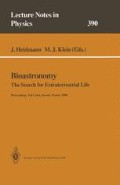Abstract
A central event in the origin of life was the self-assembly of amphiphilic compounds into closed microenvironments. If a primitive macromolecular replicating system could be encapsulated within a vesicular membrane, the components of the system would share the same microenvironment, representing a step toward indivuality and true cellular function.
What molecules might have been available on the early Earth to participate in the formation of such boundary structures? We have investigated primitive organic mixtures present in carbonaceous meteorites such as the Murchison meteorite, which typically contain 1–2 percent of their mass in the form of organic compounds. It is likely that such compounds contributed to the inventory of organic carbon on the prebiotic earth and were available to participate in chemical evolution leading to the emergence of the first cellular life forms. We found that Murchison components extracted into non-polar solvent systems are surface-active, a clear indication of amphiphilic character DDeamer and Pashley, Origins of Life and Evolution of the Biosphere 19 (1989) 21–33). One acidic fraction self-assembles into vesicular membranes that provide permeability barriers to polar solutes. Other evidence indicates that the membranes are bimolecular layers similar to those formed by contemporary membrane lipids. We conclude that bilayer membrane formation by primitive amphiphiles on the early Earth is feasible. However, only a minor fraction of acidic amphiphiles assembled into bilayers, and the resulting membranes required narrowly defined conditions of pH and ionic composition to be stable. It seems unlikely, therefore, that meteoritic infall was a direct source of membrane amphiphiles. Instead, the hydrocarbon components and their derivatives would provide an organic stock for chemical evolution in which membranogenic amphiphiles were generated. One possible reaction is photochemical oxidation of hyrdrocarbons. We found that pyrene, a major polycyclic aromatic hydrocarbon of carbonaceious meteorites, acts as a photosensitizer in the hydroxylation of long chain hydrocarbons. This reaction is significant, in that a non-polar species (the hydrocarbon) becomes a surface-active molecule which would be available to partake in self-assembly of early membranes.
Access this chapter
Tax calculation will be finalised at checkout
Purchases are for personal use only
Author information
Authors and Affiliations
Editor information
Rights and permissions
Copyright information
© 1991 Springer-Verlag
About this paper
Cite this paper
Deamer, D.W. (1991). Self-assembly properties of primitive organic compounds. In: Heidmann, J., Klein, M.J. (eds) Bioastronomy. Lecture Notes in Physics, vol 390. Springer, Berlin, Heidelberg. https://doi.org/10.1007/3-540-54752-5_199
Download citation
DOI: https://doi.org/10.1007/3-540-54752-5_199
Published:
Publisher Name: Springer, Berlin, Heidelberg
Print ISBN: 978-3-540-54752-5
Online ISBN: 978-3-540-46447-1
eBook Packages: Springer Book Archive

